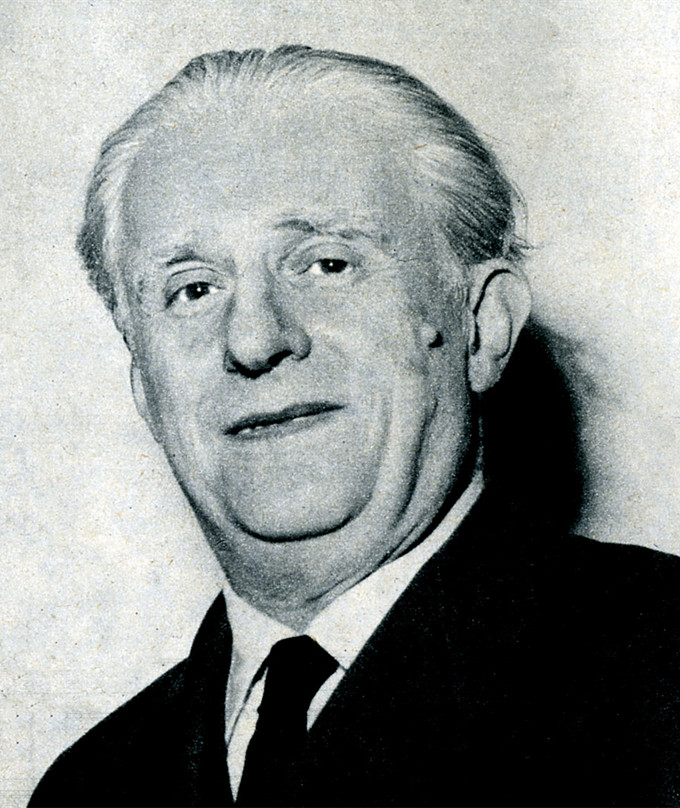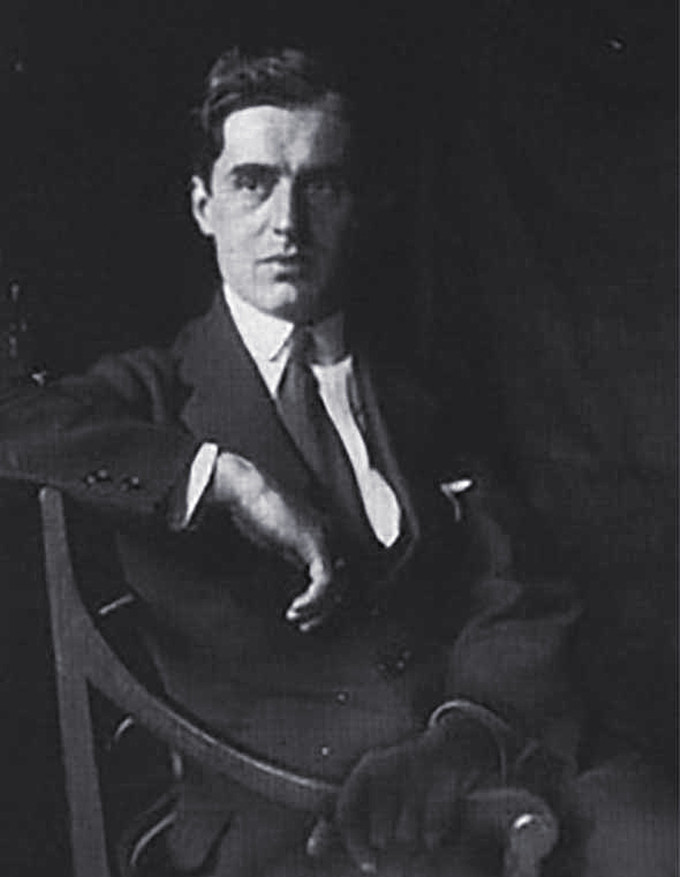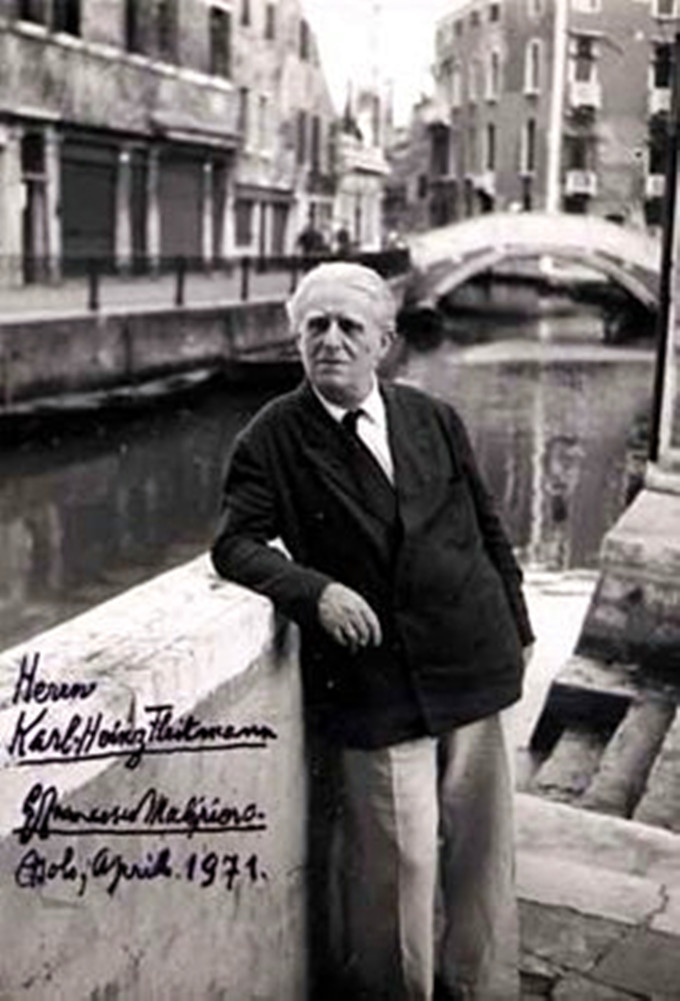| |
|
|
|
|
|
|
|
|
|
|
| |
| |
| |
田润德
编译
文/图 2020-08-01 19:36 |
|
| |
|
|
|
|
| |
 |
|
|
|
| |
马利皮耶罗(Gian
Malipiero,1882——1973) |
|
|
|
| |
|
|
|
|
| |
【歌剧】奥菲欧 by 蒙特威尔第( L'Orfeo,Claudio Monteverdi,2007)
|
|
|
|
| |
作曲家:克劳迪奥·蒙特威尔第
表演者:Graciela Oddone, Simon Keenlyside, Juanita Lascarro, Martina Dike
指挥:雷内·雅各布斯
乐团:根特声乐学院合奏团 |
|
|
|
| |
Composer: Claudio Monteverdi
Performer: Graciela Oddone, Simon Keenlyside, Juanita Lascarro, Martina
Dike
Conductor: René Jacobs
Orchestra/Ensemble: Ghent Collegium Vocale, Concerto Vocale |
|
|
|
| |
|
|
|
|
| |
音乐历史上的今天
1973年8月1日,蒙特威尔第全集以及维瓦尔第大部分作品的编辑者乔安.弗朗切斯库.马利皮耶罗(Gian Francesco
Malipiero,1882——1973)在特雷维索去世,终年91岁,活得比他自己的作品长。
G.F.马利皮耶罗(1882~1973)意大利作曲家、音乐学家。1882年
3月18日生于威尼斯,1973年8月1日卒于特雷维索,出身音乐世家。1898~1899年求学于维也纳音乐学院。1904年毕业于威尼斯马切洛音乐学院,是M.E.博西的学生。1902年他在马尔恰纳图书馆发现并抄录了久已被人忘怀的意大利早期音乐家C.蒙泰韦尔迪、G.弗雷斯科巴尔迪、A.维瓦尔迪等人的作品。1905~1906年任盲人作曲家A.斯马雷利亚的记谱员,学到了不少配器知识。1913年,在巴黎同A.卡塞拉结成共为意大利现代音乐而奋斗的亲密战友。1921年任帕尔马音乐学院作曲教授,3年后辞职赴阿索洛定居。1939年,返威尼斯任马切洛音乐学院院长,1952年退休后,继续从事私人教学和主持“意大利A.维瓦尔迪学会”。马利皮耶罗是现代意大利音乐中新巴罗克音乐的代表人物。他的作品反映了17和18世纪威尼斯音乐的精神。他的歌剧从蒙泰韦尔迪的音乐中吸取灵感,是现代风格与古代风格相融合的产物。他的器乐曲既回避主题的发展,也不采用对位的手法,并且反对真实主义。他作有30多部歌剧,包括两部歌剧三联剧《奥尔菲德》(1925)和《威尼斯的奥秘》(1932),以及根据莎士比亚戏剧创作的《尤利乌斯•凯撒》(1936)和《安东尼和克莉奥佩特拉》(1938),以及《浪子》(1953)等。还有11首交响曲、3套冠名《真实的印象》(1910~1922)和2套名为《静止》(1917~1926)的管弦乐曲、2首小提琴协奏曲(1932,1963)、6首钢琴协奏曲(1934~1964)和长笛协奏曲(1968)等。
马利皮埃罗(Malipiero,Gian Francesco
)入维也纳音乐学院曾主修小提琴。1899年回威尼斯,师从意大利管风琴家兼作曲家博西(Bossi,1861-1925)。1913年至巴黎,受印象乐派影响。1921-1923年任帕尔马音乐学院作曲教授。1939年任威尼斯马切洛音乐学院院长。其创作遵循巴洛克时期创作道路,善于复调写作。音乐作品很多,并曾因编辑蒙特威尔第维瓦尔第的全集而闻名。
今日视频:1、蒙特威尔第歌剧奥菲欧;2、维瓦尔第四季 The Four Seasons (卡拉扬指挥,安妮-索菲·穆特演奏)。 |
|
|
|
| |
 |
|
| |
年轻的马利皮耶罗(Gian
Malipiero,1882——1973) |
|
|
|
| |
Today in the
history of music
Joanne Monteverdi, editor of the complete works of Monteverdi and most
of Vivaldi's works, August 1, 1973. Gian Francesco Malipiero (1882 --
1973) died in Treviso at the age of 91, having outlived his own work.
G.F. Malipiero (1882 ~ 1973) was an Italian composer and musicologist.
Born in Venice on 18 March 1882 and died in Treviso on 1 August 1973, he
came from a musical family. He studied at the Vienna Conservatory of
Music from 1898 to 1899. He graduated from the Marcello Conservatory in
Venice in 1904 as a student of M.E. Bossi. In 1902 he discovered and
transcribed in the Marciana library the long-forgotten early Italian
musician C. Works by Monteverdi, G. Frescobaldi, A. Vivaldi and others.
From 1905 to 1906, he worked as A scribe for the blind composer A.
Smarrella, and learned a lot about orcheography. In 1913, in Paris, he
and A. Casella became close comrades in arms in the struggle for modern
Italian music. In 1921 he became a professor of composition at the
Conservatory of Music in Parma. Three years later he resigned and
settled in Asolo. In 1939, he returned to Venice and became director of
the Marcello Conservatory. After his retirement in 1952, he continued to
teach privately and conduct "Italy A. The Vivaldi Society ". Malipiero
is the representative figure of neo-Baroque music in modern Italian
music. His works reflect the spirit of Venetian music in the 17th and
18th centuries. His operas, inspired by the music of Monteverdi, are a
mixture of modern and ancient styles. His instrumental music avoids the
development of theme, does not use counterpoint technique, and opposes
realism. He wrote more than 30 operas, including two operatic triptychs,
"Orfield" (1925) and "The Mystery of Venice" (1932), as well as
Shakespeare's plays, "Julius Caesar" (1936) and "Antony and Cleopatra"
(1938), and "The Prodigal Son" (1953). There are also 11 symphonies,
three sets of works titled "True Impression" (1910-1922), two sets of
orchestral works titled "Stillness" (1917-1926), two violin concertos
(1932,1963), six piano concertos (1934-1964) and flute concertos (1968).
Malipiero Gian Francesco studied violin at the Vienna Conservatory of
Music. He returned to Venice in 1899 and studied with the Italian
organist and composer Bossi (1861-1925). 1913 to Paris, influenced by
the Impressionists. Professor of composition at the Conservatoire de
Parma from 1921 to 1923. In 1939 he became director of the Marcello
Conservatory in Venice. His works follow the path of the Baroque period
and he is good at polyphonic writing. He has many musical compositions
and is famous for editing the complete works of Monteverdi Vivaldi.
Video of the day: 1. Orfeo, Monteverdi Opera; 2. The Four Seasons of
Vival (Conducted by Karajan, performed by Anne-Sophie Mutter). |
|
|
|
| |
 |
|
| |
马利皮耶罗(Gian
Malipiero,1882——1973) |
|
|
|
| |
马利皮埃罗(Malipiero,Gian Francesco
1882-1973)意大利人。入维也纳音乐学院,主修小提琴。1899年回威尼斯,师从意大利管风琴家兼作曲家博西(Bossi,1861-1925)。1913年至巴黎,受印象乐派影响。1921-1923年任帕尔马音乐学院作曲教授。1939年任威尼斯马切洛音乐学院院长。其创作遵循巴洛克时期创作道路,善于复调写作。音乐作品很多,并曾编辑蒙特威尔第维瓦尔第的全集。 |
|
|
|
| |
Malipiero,
Gian Francesco (1882-1973) Italians.He attended the Vienna Conservatory
and majored in violin.He returned to Venice in 1899 and studied under
The Italian organist and composer Bossi (Bossi, 1861-1925).1913 to
Paris, influenced by the Impressionist school.Professor of composition,
Palma Conservatory of Music, 1921-1923.In 1939 he became dean of the
Marcello Conservatory in Venice.His creation follows the creative path
of The Baroque period and is good at polyphonic writing.He has many
musical works and edited the complete works of Monteverdi Vivaldi. |
|
|
|
| |
 |
|
| |
克劳迪奥·蒙特威尔地(Claudio Monteverdi,1567—1643),他的作品全集是马利皮耶罗(Gian
Malipiero,1882——1973)编辑出版。 |
|
|
|
| |
Claudio Monteverdi (1567 --
1643), whose complete works were edited and published by Gian Malipiero
(1882 -- 1973). |
|
|
|
| |
意大利作曲家。曾先后任曼图亚宫廷乐师及威尼斯圣马可教堂乐长。1637年在威尼斯建立第一家公众歌剧院。他是现代管弦乐的先驱。在文艺复兴末期创立了威尼斯歌剧乐派。还创作了许多宗教音乐作品和牧歌。其牧歌标志着意大利文艺复兴后期世俗音乐发展的顶峰。主要作品有《奥菲欧》(1607)、《尤利西斯的归来》、《波佩阿的加冕》等及《世俗牧歌集》九卷。
克劳迪奥·蒙特威尔地(Claudio
Monteverdi,1567年5月15日—1643年11月29日),意大利杰出的歌剧作曲家,是前期巴罗克乐派最重要的代表人物之一。二十岁时完成了他的处女作《五声部牧歌》,由此一举成名。他的音乐犹如人的躯体,富有鲜明的个性和炽烈的热情,从而将巴罗克音乐推向高潮。他注意吸取前人的经验,巧妙地运用传统的复调音乐手法,把乐曲的形式固定在歌剧中,并明确规定音乐的表现手法必须服从于戏剧情节的需要。他的歌剧感情色彩浓厚,重视对人物心理方面的刻画,并首创以管弦乐队来伴奏歌剧,为音乐的展开提供了广阔的余地。其作品大胆运用不协和和弦,利用序曲、重唱、间奏曲以加强戏剧音乐的表现力与舞台气氛。又创用弓弦乐器的手震音、拨弦奏法,充分发挥各种乐器的性能,为近代管弦乐法的先导。 |
|
da'd |
|
| |
Italian
composer.He was a musician in the court of Mantua and music master of
St. Mark's Basilica in Venice.The first public opera house was built in
Venice in 1637.He was a pioneer of modern orchestral music.The Venetian
Operatic school was founded at the end of the Renaissance.He also
composed many religious music works and eclogues.Its eclogue marked the
culmination of the development of secular music in the late Italian
Renaissance.His major works include Orfio (1607), The Return of Ulysses,
the Coronation of Popea, and the Nine volumes of the Secular Idyls.
Claudio Monteverdi (May 15, 1567 -- November 29, 1643) was an Italian
opera composer and one of the most important representatives of the
baroque school.He rose to fame at the age of twenty when he completed
his first work, The Five-Part Idyll.His music is like a human body, full
of distinct personality and fiery passion, which pushes baroque music to
its climax.He drew attention to the experience of predecessors,
skillfully used the traditional polyphonic musical technique, fixed the
form of music in the opera, and clearly stipulated that the musical
expression must be subordinate to the needs of the dramatic plot.His
operas are full of emotional color and attach importance to the
depiction of the psychological aspects of the characters. He also
pioneered the use of orchestral accompaniment in operas, which provided
broad space for the development of music.His works boldly use discordant
chords, overture, duet, intermezzo to enhance the performance of drama
music and the atmosphere of the stage.It also invented the hand-tremolo
and harpsichord playing with bowstring instruments to give full play to
the performance of all kinds of instruments, which was the forerunner of
modern orchestral music. |
|
|
|
| |
|
|
|
|
| |
 |
|
| |
安东尼奥·维瓦尔第(Antonio Lucio Vivaldi,1678-1741),他的大部分作品是马利皮耶罗(Gian
Malipiero,1882——1973)编辑出版。 |
|
|
|
| |
Antonio Lucio Vivaldi
(1678-1741), most of whose works were edited and published by Gian
Malipiero (1882 -- 1973). |
|
|
|
| |
安东尼奥·卢奇奥·维瓦尔第(意大利语:Antonio Lucio
Vivaldi,1678年3月4日-1741年7月28日),男,是一位意大利神父,也是巴洛克音乐作曲家,同时还是一名小提琴演奏家。
巴洛克时期意大利著名的作曲家、小提琴家。出生在威尼斯一个普通乐师的家庭里。维瓦尔第的父亲是威尼斯圣马可教堂乐队的小提琴手。幼年的维瓦尔第成长在威尼斯浓郁的音乐文化氛围里,显示出非凡的音乐才能,到十岁时,他已经能代替父亲在教堂里演奏了。十八世纪初的一本威尼斯旅游手册中记载:“……最佳小提琴手巴蒂斯特·维瓦尔第和他的儿子安东尼奥·维瓦尔第”的词句。
维瓦尔第十五岁受戒,1703年领受神职,但当时这并不表示他已当神父,只是为了稍微提高一下自己的社会地位。当他18岁时接受更高一级的圣职(副助祭)时,维瓦尔第才力下心当神职人员。他在附近的两个教区接受了神职教育(神学)并毕业。25岁时,维瓦尔第成为神父。由于他生有一头红发,人们都称他为“红发神父”。接着他就当上了S.
Maria della
Pietà教堂的神甫,并且在教堂属下的女童音乐学院中当小提琴教师。在维瓦尔第的悉心指导下,孤儿院乐队和唱诗班的水平蒸蒸日上,他本人作为一个作曲家和小提琴演奏家的声望也越过了阿尔卑斯山,一些爱好音乐的贵族千里迢迢来到威尼斯,只是为了聆听他演奏小提琴。在维瓦尔第任教近四十年的时间里,大量音乐作品源源不断的从他的鹅毛笔端流淌出来,最出色的还是他以富于民间色彩和生活气息着称的器乐作品。他一生写了近500首协奏曲和73首奏鸣曲,此外,还作有歌剧十余部,以及康塔塔、经文歌等。其中相当一部分在他在世时就出版了,包括他最著名的作品小提琴协奏曲《四季》。 |
|
|
|
| |
Antonio Lucio
Vivaldi (4 March 1678 -- 28 July 1741) was an Italian priest, composer
of Baroque music, and violinist.
Italian composer and violinist of the Baroque period.He was born into a
family of ordinary musicians in Venice.Vivaldi's father was a violinist
in St. Mark's Basilica in Venice.Growing up in Venice's rich musical
culture, vivaldi showed exceptional musical ability, and by the age of
ten he was playing in church in place of his father.An early eighteenth
century Venice tourist brochure states: "...The best violinist, Baptiste
Vivaldi and his son, Antonio Vivaldi."
Vival was ordained at the age of fifteen, and received the priesthood in
1703, but at the time this did not mean that he had become a priest,
only to raise his social status a little.Vivaldi became a priest when,
at the age of 18, he received the higher orders (deacons).He received
his clerical education (theology) in two nearby parishes and
graduated.Vivaldi became a priest at the age of 25.As he had red hair,
he was called the "Father with Red hair".Then he became priest at The
Church of S. Maria Della Pieta, and taught the violin at the girl's
conservatory under the church.Under Vivaldi's careful guidance,
orphanage bands and choirs flourished, his own reputation as a composer
and violinist spread across the Alps, and music-loving aristocracy came
to Venice just to hear him play his violin.In vivaldi's nearly forty
years of teaching, a great deal of music flowed from his goose feather
pen, and the most outstanding was his instrumental music, which was full
of folk color and life atmosphere.In his lifetime, he wrote nearly 500
concertos and 73 sonatas. In addition, he also composed more than ten
operas, cantata, sutras and so on.Many of them were published while he
was still alive, including his most famous work, the Four Seasons, a
violin concerto. |
|
|
|
| |
|
|
|
|
| |
 |
|
|
|
| |
维瓦尔第小提琴协奏曲《四季》 |
|
|
|
| |
小提琴协奏曲《四季》大约作于1725年,是维瓦尔第大约五十岁时发表并献给波希米亚伯爵莫尔津的一套大型作品《和声与创意的尝试》共十二部协奏曲的第一号到第四号,合称《四季》。这四部协奏曲是维瓦尔第最著名的作品,其中的旋律至今仍长盛不衰。四部作品均采用三乐章协奏曲形式的正宗标题音乐,不仅照给定的十四行诗配上音乐,而且还运用了不少描写手法。维瓦尔第在总奏与主奏交替形成的复奏形式上,巧妙地配以标题。《四季》的标题分别为:
《春》E大调、《夏》g小调、《秋》F大调、《冬》f小调。其中以《春》的第一乐章(快板)最为著名,音乐展开轻快愉悦的旋律,使人联想到春天的葱绿;《夏》则出乎意料之外,表现出夏天的疲乏、恼人;《秋》描写的是收获季节中,农民们饮酒作乐、庆祝丰收的快活景象,这个乐章欢快而又活泼;《冬》描写人们走在冰上滑稽的姿态,以及由炉旁眺望窗外雪景等景象,其中第二乐章非常出名,曾被改编为轻音乐而广为流传。
【乐章列表】
E大调第一协奏曲,Op. 8,RV 269,《春》("La primavera")
1. 快板(Allegro)
2. 广板(Largo)
3. 快板
G小调第二协奏曲,Op. 8,RV 315,《夏》("L'estate")
1. 不太快的快板(Allegro non molto)
2. 柔板及弱拍-急板及强音(Adagio e piano - Presto e forte)
3. 急板(Presto)
F大调第三协奏曲,Op. 8,RV 293,《秋》("L'autunno")
1. 快板
2. 极柔板(Adagio molto)
3. 快板
F小调第四协奏曲,Op. 8,RV 297,《冬》("L'inverno")
1. 不太快的快板
2. 广板
3. 快板
这四首协奏曲各附有一首十四行诗。作者不详(有人认为是作曲家原创)。译文如下。
《春》
【快板】
春临大地,
众鸟欢唱,
和风吹拂,
溪流低语。
天空很快被黑幕遮蔽,
雷鸣和闪电宣示暴风雨的前奏;
风雨过境,鸟花语再度
奏起和谐乐章。
【广板】
芳草鲜美的草原上,
枝叶沙沙作响,喃喃低语;
牧羊人安详地打盹,脚旁睡着夏日懒狗。
【快板】
当春临大地,
仙女和牧羊人随着风笛愉悦的旋律,
在他们的草原上婆娑起舞。
《夏》
【不太快的快板】
奄奄一息的人们和动物躺在
炽热无情的太阳底下,
松树仿佛就要起火;
杜鹃高歌著,加入斑鸠和金翅雀的行列中。
微风轻拂,
但很快地大风卷起;
若有风雨欲来之势,
牧羊人被突如其来的狂风惊吓。
【柔板及弱拍-急板及强音】
担心着他的羊群以及自己的命运,
他开始忙着做风雨前的准备,不安的心在灰暗的天色下、
蚊蝇的嗡嗡作响下显得更加孤立无援。
【急板】
终于,他担心的事发生了——
雷电交加的狂风暴雨及冰雹
阻挠了他回家的路。
《秋》
【快板】
农人唱歌跳舞,
庆祝庄稼的丰收。
酒神的琼浆玉液使
众人在欢愉的气氛中沉沉睡去。
【极柔板】
在歌声及舞蹈停止之时,
大地重回宁静,
万物随庄稼的人们
在秋高气爽中一同进入梦乡。
【快板】
破晓时分号角响起,
猎人带着猎狗整装待发。
鸟兽纷逃,而猎人开始追寻猎物的行踪。
一阵枪声剧响夹杂猎狗的狂吠之后,
动物四窜奔逃,但终奄奄一息,
不敌死神的召唤。
《冬》
【不太快的快板】
人们在凛冽的寒风中、
在沁冷的冰雪里不住发抖。
靠着来回跺步来保持体温,
但牙齿仍不住地打颤。
【广板】
在滂沱大雨中坐在火炉旁度过
安静而美好的时光。
【快板】
小心翼翼地踩着步伐前进,
深怕一个不留神栽了个斤斗;
有时在冰上匆匆滑过,
跌坐在雪上,来回地跑步玩耍。
直到冰裂雪融的时刻,听见温暖的南风已轻叩
冷漠的冰雪大门。
这是冬天,
一个愉快的冬天。 |
|
|
|
| |
|
|
|
|
| |
|
|
| |
【维瓦尔第】四季 The Four Seasons (卡拉扬指挥,安妮-索菲·穆特演奏) |
|
|
|
| |
小提琴协奏曲《四季》大约作于1725年,是维瓦尔第大约五十岁时发表并献给波希米亚伯爵莫尔津的一套大型作品《和声与创意的尝试》共十二部协奏曲的第一号到第四号,合称《四季》。这四部协奏曲是维瓦尔第最著名的作品,其中的旋律至今仍长盛不衰。四部作品均采用三乐章协奏曲形式的正宗标题音乐,不仅照给定的十四行诗配上音乐,而且还运用了不少描写手法。维瓦尔第在总奏与主奏交替形成的复奏形式上,巧妙地配以标题。《四季》的标题分别为:
《春》E大调、《夏》g小调、《秋》F大调、《冬》f小调。其中以《春》的第一乐章(快板)最为著名,音乐展开轻快愉悦的旋律,使人联想到春天的葱绿;《夏》则出乎意料之外,表现出夏天的疲乏、恼人;《秋》描写的是收获季节中,农民们饮酒作乐、庆祝丰收的快活景象,这个乐章欢快而又活泼;《冬》描写人们走在冰上滑稽的姿态,以及由炉旁眺望窗外雪景等景象,其中第二乐章非常出名,曾被改编为轻音乐而广为流传。 |
|
|
|
| |
未得原作者编者授权严禁转载www.mt77.com任何内容 |
|
|
|
|
|
|
|
|
|
|
|
|
|
|
.png)


